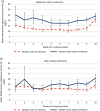Current or recent malaria infection is associated with elevated inflammation-adjusted ferritin concentrations in pre-school children: a secondary analysis of the BRINDA database
- PMID: 39450524
- PMCID: PMC11600282
- DOI: 10.1017/S0007114524002319
Current or recent malaria infection is associated with elevated inflammation-adjusted ferritin concentrations in pre-school children: a secondary analysis of the BRINDA database
Abstract
Inflammation and infections such as malaria affect micronutrient biomarker concentrations and hence estimates of nutritional status. It is unknown whether correction for C-reactive protein (CRP) and α1-acid glycoprotein (AGP) fully captures the modification in ferritin concentrations during a malaria infection, or whether environmental and sociodemographic factors modify this association. Cross-sectional data from eight surveys in children aged 6-59 months (Cameroon, Cote d'Ivoire, Kenya, Liberia, Malawi, Nigeria and Zambia; n 6653) from the Biomarkers Reflecting Inflammation and Nutritional Determinants of Anaemia (BRINDA) project were pooled. Ferritin was adjusted using the BRINDA adjustment method, with values < 12 μg/l indicating iron deficiency. The association between current or recent malaria infection, detected by microscopy or rapid test kit, and inflammation-adjusted ferritin was estimated using pooled multivariable linear regression. Age, sex, malaria endemicity profile (defined by the Plasmodium falciparum infection prevalence) and malaria diagnostic methods were examined as effect modifiers. Unweighted pooled malaria prevalence was 26·0 % (95 % CI 25·0, 27·1) and unweighted pooled iron deficiency was 41·9 % (95 % CI 40·7, 43·1). Current or recent malaria infection was associated with a 44 % (95 % CI 39·0, 52·0; P < 0·001) increase in inflammation-adjusted ferritin after adjusting for age and study identifier. In children, ferritin increased less with malaria infection as age and malaria endemicity increased. Adjustment for malaria increased the prevalence of iron deficiency, but the effect was small. Additional information would help elucidate the underlying mechanisms of the role of endemicity and age in the association between malaria and ferritin.
Keywords: Ferritin; Inflammation; Malaria infection.
Figures



References
-
- Lynch SR (2011) Why nutritional iron deficiency persists as a worldwide problem. J Nutr 141, 763S–768S. - PubMed
-
- Northrop-Clewes CA (2008) Interpreting indicators of iron status during an acute phase response--lessons from malaria and human immunodeficiency virus. Ann Clin Biochem 45, 18–32. - PubMed
MeSH terms
Substances
LinkOut - more resources
Full Text Sources
Research Materials
Miscellaneous

